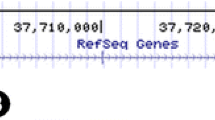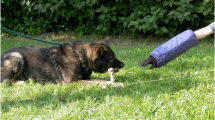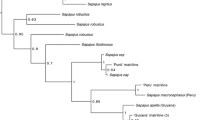Abstract
Although humans and canines exhibit similar behavioral features, it is not easy to identify the corresponding behavioral phenotypes. The variable number of tandem repeats (VNTR) in intron 4 of the tyrosine hydroxylase (TH) gene is related to two characteristics, namely, impulsive activity and inattention. The TH genes are defined by three genotypes: type 1/1 comprises a single copy of TH VNTR; type 1/2 is heterozygote for both short allele and long allele; and type 2/2 is the doubled form of TH VNTR, which leads to inattention and impulsive actions. The 1/1 and 1/2 genotype have been identified as biomarkers for concentration and impulsive action. Therefore, we performed PCR amplification to detect the 1/2 genotypes in three canine breeds from Korea: Sapsaree (49), Poongsan (18), and Jindo (20). Our results indicate that the Sapsaree dog carries 27 % of the 2/2 genotype, 59 % of the 1/2 genotype, and 14 % of the 1/1 genotype; the Poongsan dog carries 11 % of the 2/2 genotype, 22 % of 1/2 genotype, and 67 % of 1/1 genotype; whereas the Jindo dog carries 10 % of the 2/2 genotype, 40 % of the 1/2 genotype, and 50 % of the 1/1 genotype. Taken together, our data indicate that the Jindo, Poongsan, and Sapsaree dogs harbor decreasing amounts of phenotypes responsible for inattention and impulsive behavior, in that order. Additionally, the Sapsaree genes harbor higher amounts of the 1/2 genotype than the Jindo and Poongsan genes, respectively.


Similar content being viewed by others
References
Berka N, Nunlee-Bland G, Erabhaoui E, Belmamoun M, Dunston GM (2004) IDDM2 and the polymorphism of the human tyrosine hydroxylase (hTH) gene in African Americans with type-1 diabetes. J Natl Med Assoc 96:1042–1046
Eo J, Choi BH, Jung YD, Kwon YJ, Kim TH, Seong HH, Kim HS (2013) Polymorphism analysis of tyrosine hydroxylase (TH) in military working dogs. Genes Genom 35:817–821
Hejjas K, Vas J, Kubinyi E, Sasvari-Szekely M, Miklόsi Á, Ronai Z (2007) Novel repeat polymorphisms of the dopaminergic neurotransmitter genes among dogs and wolves. Mamm Genome 18:871–879
Hejjas K, Kubiniyi E, Ronai Z, Szekely A, Vas J, Miklόsi Á, Sasvari-Szekely M, Kereszturi E (2009) Molecular and behavioral analysis of the intron 2 repeat polymorphism in the canine dopamine D4 receptor gene. Genes Brain Behav 8:330–336
Inoue-Murayama M, Adachi S, Mishima N, Mitani H, Takenaka O, Terao K, Hayasaka I, Ito S, Murayama Y (2002) Variation of variable number of tandem repeat sequences in the 3′-untranslated region of primate dopamine transporter genes that affects reporter gene expression. Neurosci Lett 334:206–210
Ito H, Nara H, Inoue-Murayama M, Shimada MK, Koshimura A, Ueda Y, Kitagawa H, Takeuchi Y, Mori Y, Murayama Y et al (2004) Genotype frequency distribution of the canine dopamine receptor D4 gene exon III and I in 23 breeds. J Vet Med Sci 66:815–820
Kubinyi E, Vas J, Hejjas K, Ronai Z, Brúder I, Turcsán B, Sasvari-Szekely M, Miklόsi Á (2012) Polymorphism in the tyrosine hydroylase(TH) gene is associated with activity-impulsiviry in German Shepherd dogs. PLoS ONE 7:e30271
Kurumaji A, Kuroda T, Yamada K, Yoshikawa T, Toru M (2001) An association of the polymorphic repeat of tetranucleotide (TCAT) in the first intron of the human tyrosine hydroxylase gene with schizophrenia in a Japanese sample. J Neural Transm 108:489–495
Lit L, Belanger JM, Boehm D, Lybarger N, Haverbeke A, Diederich C, Oberbauer AM (2013) Characterization of a dopamine transporter polymorphism and behavior in Belgian Malinois. BMC Genet 14:45
Lowe N, Kirley A, Mullins C, Fitzgerald M, Gill M, Hawi Z (2004) Multiple marker analysis at the promoter region of the DRD4 gene and ADHD: evidence of linkage and association with the SNP−616. Am J Med Genet 131B:33–37
Olsson C, Anney R, Forrest S, Patton G, Coffey C, Cameron T, Hassett A, Williamson R (2004) Association between dependent smoking and a polymorphism in the tyrosine hydroxylase gene in a prospective population-based study of adolescent health. Behav Genet 34:1
Pollinger JP, Bustamante CD, Adi Fledel-Alon A, Schmutz S, Gray MM, Wayne RK (2005) Selective sweep mapping of genes with large phenotypic effects. Genome Res 15:1809–1819
Serretti A, Cusin C, Cristina S, Lorenzi C, Lilli R, Lattuada E, Grieco G, Costa A, Santorelli F, Barale F et al (2003) Multicentre Italian family-based association study on tyrosine hydroxylase, catechol-O-methyl transferase and Wolfram syndrome 1 polymorphisms in mood disorders. Psychiatr Genet 13:121–126
Takeuchi Y, Kaneko F, Hashizume C, Masuda K, Ogata N, Maki T, Inoue-Murayama M, Hart BL, Mori Y (2009) Association analysis between canine behavioural traits and genetic polymorphisms in the Shiba Inu breed. Animal Genet 40:616–622
Topál J, Miklósi Á, Gácsi M, Dóka A, Pongrácz P, Kubinyi E, Virányi Z, Csányi V (2009) The dog as a model for understanding human social behavior. Adv Stud Behav 39:71–116
Wan M, Hejjas K, Ronai Z, Elek Z, Sasvari-Szekely M, Campagne FA, Miklόsi Á, Kubinyi E (2013) DRD4 and TH gene polymorphisms are associated with activity, impulsivity and inattention in Siberian Husky dogs. Anim Genet 44:717–727
Acknowledgments
This research was supported by awards from the AGENDA project (Project No. PJ009254) in the National Institute of Animal Science, Rural Development Administration (RDA).
Conflict of Interest
There is no conflict of interest regarding the publication of this paper.
Author information
Authors and Affiliations
Corresponding author
Additional information
Hee-Eun Lee and Bong-Hwan Choi these authors contributed equally to this work.
Rights and permissions
About this article
Cite this article
Lee, HE., Choi, BH., Lee, DH. et al. Polymorphism analysis of tyrosine hydroxylase gene variable number of tandem repeats in various Korean dogs. Genes Genom 37, 257–261 (2015). https://doi.org/10.1007/s13258-014-0243-4
Received:
Accepted:
Published:
Issue Date:
DOI: https://doi.org/10.1007/s13258-014-0243-4




